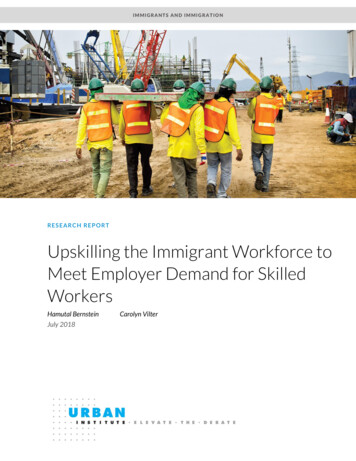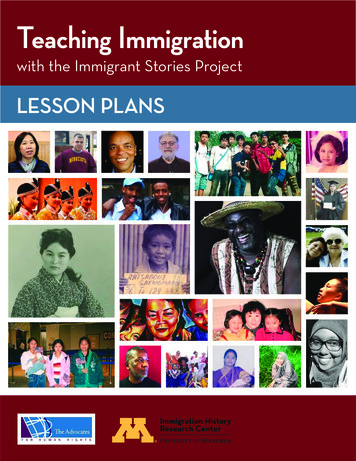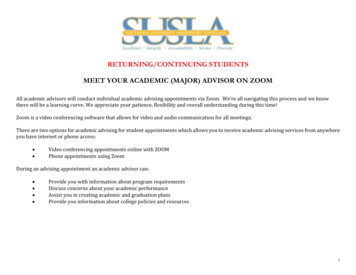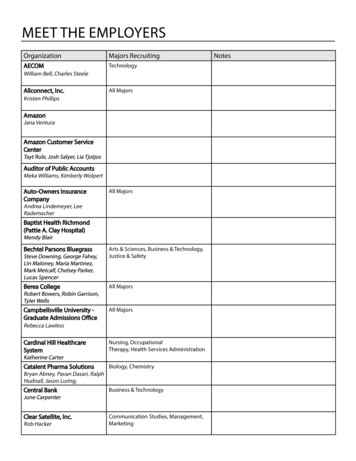
Transcription
IMMIGRANTS AND IMMIG RATIONRE S E AR CH RE P O R TUpskilling the Immigrant Workforce toMeet Employer Demand for SkilledWorkersHamutal BernsteinJuly 2018Carolyn Vilter
AB O U T T HE U R BA N I NS T I T U TEThe nonprofit Urban Institute is a leading research organization dedicated to developing evidence-based insightsthat improve people’s lives and strengthen communities. For 50 years, Urban has been the trusted source forrigorous analysis of complex social and economic issues; strategic advice to policymakers, philanthropists, andpractitioners; and new, promising ideas that expand opportunities for all. Our work inspires effective decisions thatadvance fairness and enhance the well-being of people and places.Copyright July 2018. Urban Institute. Permission is granted for reproduction of this file, with attribution to theUrban Institute. Cover image courtesy of Shutterstock.
ContentsAcknowledgmentsivExecutive SummaryvUpskilling the Immigrant Workforce to Meet Employer Demand for Skilled Workers1Need for This Study2Research Approach4Basic Demographics of the Immigrant Workforce8Perspectives from Three Local Workforce Systems17Lessons for Developing Strong Middle-Skill Workforce Strategies33Appendix.Assigning Skill Requirements to American Community Survey Occupation Codes38Notes52References54About the Authors57Statement of Independence58
AcknowledgmentsThis report was funded by a grant from JPMorgan Chase. We are grateful to them and to all our funders,who make it possible for Urban to advance its mission.The views expressed are those of the authors and should not be attributed to the Urban Institute,its trustees, or its funders. Funders do not determine research findings or the insights andrecommendations of Urban experts. Further information on the Urban Institute’s funding principles isavailable at urban.org/fundingprinciples.First, we thank our interviewees, who were willing to take time away from their important workserving their communities to share their perspectives on this topic. We thank those who have providedadvice as we developed this report, including Audrey Singer, David Dyssegaard Kallick, Rachel Peric,Erica Bouris, Hadya Abdul Satar, Loh-Sze Leung, and Jeanne Batalova, and our partners at JPMorganChase. We sincerely thank our reviewers and counselors Amanda Bergson-Shilcock, Pam Loprest,Marcela Montes, and Shayne Spaulding, for their insights and support along the way. Thanks to SarahGault for earlier research assistance with the census data. Thanks go to Elizabeth Forney and Serena Leifor their assistance on copyediting.IVACKNOWLEDGMENTS
Executive SummaryIn communities across the country, many employers are having trouble finding enough skilled workers.They may be overlooking an untapped resource. A large share of immigrant workers are in lower-skilledjobs, however, with the right access to education and training they need to advance their careers, manyhave the potential to meet these labor force needs. Workforce development services could help themdevelop their skills, earn higher wages to support themselves and their families, and meet employerdemand.Immigrants make up one out of six workers in the United States. They are an often overlooked butvital part of local economies and, therefore, should be a part of local workforce development strategies.Middle-skilled jobs are an avenue for many of these workers to get good jobs without needing a fouryear degree. And employers have expressed a need for workers with bilingual and cultural skills toserve an increasingly diverse public. Many cities and organizations are engaged in upskilling theirimmigrant workforce, though it is challenging to serve this population effectively, and there is not muchsystematic knowledge about the most effective way to address barriers and design training for thisgroup.In this report, we examine the size and characteristics of the potentially untapped immigrantworkforce and the barriers to and opportunities for education, training, and workforce services. Weprovide national and metropolitan-level statistics to inform decisionmakers. We also explore strategiesthat organizations in three cities—Dallas, Miami, and Seattle—are using to support immigrant trainingand advancement and offer practice and policy recommendations for others.Here, we focus on immigrants currently employed in lower- and middle-skilled occupations andwho are authorized to work in the US. Many of the issues discussed in this report also apply toundocumented workers, who could benefit from upskilling efforts, but they are not eligible for certainfederal employment programs.Characteristics of the Immigrant WorkforceUnderstanding the characteristics of the potential immigrant middle-skilled workforce can informstrategies to support education and training efforts. We looked at the educational attainment,occupations, wages, and English proficiency of immigrant workers.
Educational AttainmentAs a whole, immigrant workers have lower educational attainment than native-born workers, althougha similar share in both groups has a college or advanced degree. 26 percent of immigrant workers have less than a high school diploma or equivalent, comparedwith 5 percent of native-born workers 21 percent of immigrant workers have a high school degree, compared with 26 percent ofnative-born workers 21 percent have some postsecondary education but less than a bachelor’s degree, comparedwith 36 percent of native-born workers 31 percent have a college degree or above, compared with 33 percent of native-born workersOccupationDespite having lower educational attainment, foreign-born workers are just as likely as native-bornworkers to hold middle-skilled jobs. This suggests that immigrant workers may be gaining some middleskilled jobs through job experience and on-the-job training rather than entering with specificcredentials required for entry into a specific job. About 25 percent of both groups have middle-skilledjobs, though immigrant workers are more likely than native-born workers to have lower-skilled jobs (50percent compared with 44 percent) and less likely to have high-skilled jobs (25 percent compared with31 percent).Among foreign-born workers, the most common lower-skilled occupations are maids andhousekeeping cleaners, janitors, construction laborers, cashiers, grounds maintenance workers, retailsalespersons, agricultural workers, and waiters. The most common middle-skilled occupations arecooks; drivers; nursing, psychiatric, and home health aides; and first-line supervisors of retail workers.Though native-born workers also hold many of these same lower- and middle-skilled occupations, theyare more likely to have secretary and customer service representative positions and much less likely towork as maids, grounds maintenance workers, and agricultural workers.WagesImmigrant workers in lower- and middle-skilled jobs earn less than their native-born counterparts. Theyhave a median wage of 21,266 compared with 24,421 among the native born with lower-skilled jobs.VIEXECUTIVE SUMMARY
And among those with middle-skilled jobs, immigrants have a median wage of 28,905 compared with 36,041 for native-born workers.Limited English ProficiencyLimited English proficiency is common among immigrant workers, though it is more common for thosewith lower-skilled jobs (60 percent) compared with those in middle-skilled jobs (52 percent) or in highskilled jobs (19 percent). Limited English proficiency is correlated with lower wages; in general, thelower-paid occupations are more likely to have workers who are limited English proficient (LEP), andthe higher-paid occupations have fewer LEP workers. But there is not a direct relationship betweenwage and LEP rate. Some higher-paying occupations in construction and related fields have a largemajority of LEP workers. There are also LEP workers in some first-line supervisor positions, which tendto be better paid. There are some other well-paying jobs (for the native born) that immigrants are notattaining at comparable rates, which could offer paths to better wages and could be reached with someupskilling in English, career readiness, or technical training.The results suggest that certain types of training and education are needed to support immigrantupskilling and leverage their unique assets and needs across sectors and occupations. Limited Englishproficiency is a common issue among immigrants employed in lower- and middle-skilled jobs, suggestingthe importance of English language training as part of workforce development strategies for thispopulation.Barriers to Education and Training and Better JobsWe talked with service providers and stakeholders in Dallas, Miami, and Seattle to better understandthe challenges that immigrants face in pursuing education and training. Many described the followingbarriers. Limited English proficiency. Many service providers said that limited English proficiency is asignificant barrier to promotion and higher wages and can make workers vulnerable to abuse inthe workplace. In the cities we visited, the demand for English language training is greater thanthe supply. Service providers said that English as a Second Language (ESL) instruction should becustomized for different needs, but existing classes are rarely able to support the wide range ofimmigrant backgrounds and skill levels. They also noted that employers and policymakersEXECUTIVE SUMMARYVII
sometimes have unrealistic expectations about how quickly students can advance in theirEnglish proficiency. Difficulty transferring foreign credentials and overseas job experience to the US job market.Immigrants who have credentials and job experience in their home countries have troublefinding employment in their previous professions. Service providers said that they try to offeralternative training or career paths to immigrants with particular skill sets or try to place themin lower- or middle-skilled jobs where they can get a foot in the door rather than trying tomatch them with jobs similar to the ones they held in their home countries. Low digital literacy and low basic skills. Many service providers described how some of theirimmigrant clients need training in basic computer skills, which matter for a wide range of jobsand for accessing workforce services and tools. Workers with low digital literacy might alsohave more fundamental basic skills gaps and low literacy in their native languages. High housing costs and lack of transportation and child care. These three barriers are perhapsthe greatest challenges immigrant workers—and native-born workers—face for participating ineducation and training. Low wages and high housing costs drive many immigrants to workmultiple jobs, leaving little time for upskilling. Transportation challenges, such as inadequatepublic transportation and long commute times, can keep workers from pursuing education andtraining. And finding affordable quality child care is a major hurdle for many low-wage workers,including immigrant workers. Financial pressures. Service providers said that many immigrants work in “survival jobs,” whichallow them to support themselves but are not likely to lead to advancement. The financialpressure of providing for themselves and their families on low wages is a major barrier toinvesting time and money in education and training.In addition, service providers grapple with their own challenges to supporting education, training,and workforce services and supports. These include raising funds to develop and maintain programs,managing complex and sometimes contradictory performance reporting requirements from differentfunding sources, and working with the federal workforce system structure implemented through theWorkforce Innovation and Opportunity Act (WIOA).VIIIEXECUTIVE SUMMARY
Strategies to Support Immigrant Workers and Develop aStrong Middle-Skilled WorkforceDespite these challenges, many organizations are designing workforce development services forimmigrant workers and helping them address their barriers to participation. The following strategiesinclude approaches to training that consider workers’ needs and solutions to increase immigrant accessto education and training. English language skill-building. Many service providers said that vocational English trainingthat integrates workforce content or combines ESL with technical training is more effective andefficient than classic ESL. Offering instruction at the workplace can make training moreaccessible and can help workers avoid additional transportation and child care costs. Training supports. Supportive services, such as help with transportation or child care, can makeit easier for workers to enroll and participate in education and training programs. Inclusive staffing. To make immigrants feel welcome and to provide the support they need tosucceed in training, organizational staff should be multilingual, culturally competent, andavailable to help participants navigate systems. Community outreach. Many service providers said that community outreach is essential forengaging immigrant communities. This may mean advertising on language-specific media,providing recruitment materials in multiple languages, or tapping into community networks. Trusted providers. The service providers we interviewed said that a common strategy foroutreach is leveraging community organizations and providing services at trusted places, likeon location at immigrant-serving community-based organizations. Collaboration with other service organizations. Collaboration across sectors allows serviceproviders to leverage resources and make training and supports more accessible to studentsand their families.Local Workforce Development Strategy Should IncludeImmigrant WorkersImmigrant workers play essential roles in local economies but are often not able to access the trainingthat would benefit themselves, their employers, and their communities. Their role in local labor marketsEXECUTIVE SUMMARYIX
and their needs should be considered in broader decisionmaking and in every community’s workforcedevelopment goals.Like native-born workers, many foreign-born workers in lower- and middle-skilled jobs are workinghard to support their families, handling high costs of living, and struggling to make ends meet with lowpaid work. Given the challenges of balancing life and work on a low income, they have limitedopportunity to invest in their own training and enhance their prospects for better-paid work and careeradvancement.It is important that communities acknowledge and address the often-overlooked immigrantworkforce that sustains their local economies and make sure that immigrants and LEP workers are apart of local economic development and workforce development strategies and conversations. There isstill too much division between immigrant-serving organizations and ESL providers, the workforcedevelopment board and community colleges, and employers who are relying on immigrant talent. Allactors would benefit from bridging that gap and coming together to engage immigrants and employersin workforce development strategies and foster immigrant upskillingInvesting in immigrant workers and their upskilling is important for a range of decisionmakersacross sectors, who may or may not have immigrant and LEP issues on their radar. State and local policymakers making policy and funding decisions can be aware of and sensitiveto the key role that immigrant workers are playing in their communities, pushing forwardworkforce and education issues. Recognizing the contributions of the immigrant community iscritical, especially at this time of restrictive immigration policies and toxic national rhetoric.Policymakers can put more resources into English language learning and encourageorganizations to serve immigrants and LEP individuals, track information about programs toassess gaps in services, and actively engage immigrant-serving organizations to ensure policy isgrounded in community needs. Organizations providing workforce development services and education and training canwork to improve program accessibility and design to serve immigrant community members.Local workforce development boards, community colleges, and school districts, whose missionis to serve the community, can assess the extent to which they are funding immigrant-servingorganizations or serving immigrant and LEP communities. They can work to improve thelinguistic and cultural competence and accessibility of programs by hiring multilingual staff andpartnering with immigrant-serving organizations to fill in gaps in visibility, language access, andcultural knowledge. Organizations should connect with immigrant-serving organizations toXEXECUTIVE SUMMARY
leverage WIOA’s opportunity for pressing forward the needs of LEP individuals as a priority ofservice population, as well as youth in immigrant families. Funders interested in supporting equity and economic mobility can consider incorporatingimmigrant populations and English language learning into their funding priorities. They canwork to ensure that these issues are reflected in their awarding of grants—that local granteesare reaching this population through direct services or incorporating an immigrant-inclusivelens in systems-level work. This might mean encouraging collaboration across sectors likeconnecting immigrant-serving ESL providers to local workforce development or economicdevelopment organizations or employers, or conducting needs assessments to inform futureinvestment. Employers who want to recruit and retain workers can invest in improving job quality byrecognizing barriers like child care and transportation and providing supports or services tohelp current employees. They can also invest in upskilling their employees through onsitetraining to foster English language learning and promote advancement. And they cancollaborate with immigrant-serving organizations and other training providers to ensure thattraining programs are informed by current industry need.This issue is even more important in our current political climate, when immigrant communities aresubject to harsh political rhetoric and are suffering the consequences of heightened immigrationenforcement and volatile immigrant policy developments. In the face of this painful debate and as manyare suffering uncertainty and family separation, each day immigrant workers continue to work tosupport their families, employers, and communities. States and local areas that are working to supporttheir immigrant residents need to keep training and education on their agenda as they developproactive policies and continue to support workers.EXECUTIVE SUMMARYXI
Upskilling the Immigrant Workforceto Meet Employer Demand forSkilled WorkersImmigrants make up one out of six workers in the US, and they support the vitality of local economiesacross the country. The foreign born are employed at high rates, but a large share have low educationalattainment and are limited in their English proficiency. Most immigrant workers with low-paying jobshave limited opportunities to pursue education and training and expand their English and technicalskills, steps that might unlock better wages and support career advancement. At the same time, withlow rates of unemployment, employers are voicing demand for workers, especially to fill middle-skilledpositions that require some postsecondary training but not a four-year college degree. Many employersneed skilled workers with bilingual and cultural skills to serve an increasingly diverse public and work ina globalized economy. It has been challenging for many local workforce systems to serve immigrantworkers effectively, but many organizations and cities are engaged in upskilling their immigrantworkforce to meet this employer demand. “Local workforce systems” here is used broadly to include notjust the federally funded public workforce system but the range of organizations across sectors thatserve and support individuals and employers,1 including education and training providers, immigrantserving organizations, and other organizations. This report examines the size and characteristics of theimmigrant workforce at the national and metropolitan levels, and explores key strategies thatorganizations in three cities are using to support training this population for better jobs.We explore barriers to and opportunities for education, training, and workforce services, focusingspecifically on employed immigrants who could help fill employer demand and should be a target ofmiddle-skill workforce development strategies. Our discussion of education and training considers arange of programming that could foster mobility of working immigrants and limited English proficient(LEP) individuals; this includes English as a second language (ESL), general career readiness andworkforce training, and technical training for specific occupations. We use recent census data toprovide a demographic profile of the immigrant workforce with national- and metropolitan-levelstatistics for the largest 100 metropolitan regions. We share insights collected through interviews withservice providers and stakeholders in Dallas, Miami, and Seattle to better understand the barriers totraining for this population and the experiences of organizations serving immigrant communities. Theresults point to the ways that local communities focused on the issue of middle-skill workforceUPSKILLING THE IMMIG RANT WORKFORCE TO MEET EMPLOYER DEMAND1
development can account for the important role that immigrants have to play and design appropriatestrategies to foster their upskilling. Strategies should address barriers that are preventing manyimmigrants from advancing out of low-wage jobs, as many immigrant workers are struggling to makeends meet with low-paid lower-skilled or middle-skilled jobs. Limited English proficiency is a majorchallenge for this group, and English language training must be a component of workforce training forthis population. It is also, however, crucial to recognize the linguistic and cultural assets that immigrantscan and do contribute, especially in key occupations and sectors that require bilingual skills whether toserve a diverse public or work with a diverse employee base.We begin with a description of the policy and research context and describe our research design,which draws on quantitative and qualitative data sources. We provide basic statistics on the immigrantworkforce and then share perspectives from the field collected through interviews with staff fromservice provider and stakeholder organizations. We conclude with practice and policyrecommendations to inform future decisionmaking to leverage the key role immigrant workers can playfor middle-skill workforce strategies.BOX 1New Skills at WorkThe Urban Institute is collaborating with JPMorgan Chase over five years to inform and assessJPMorgan Chase’s philanthropic investments in key initiatives. One of these is New Skills at Work, a 250 million multiyear workforce development initiative that aims to expand and replicate effectiveapproaches for linking education and training efforts with the skills and competencies employers need.The goals of the collaboration include using data and evidence to inform JPMorgan Chase’sphilanthropic investments, assessing whether its programs are achieving desired outcomes, andinforming the larger fields of policy, philanthropy, and practice. As one of several resources Urban isdeveloping for the field, this report focuses on immigrant workers and effective strategies for upskillingthis key segment of many local workforces.Need for This StudyThere is a broad conversation in the workforce development field and among employers about the“middle-skills gap:” the idea is that employers are in need of skilled workers with specific postsecondarycredentials but less than a four-year college degree (Holzer 2015; Kochan, Finegold, and Osterman2012; Modestino 2016).2 Though not all middle-skilled jobs offer high wages, there is a growing focus2UPSKILLING THE IMMIG RANT WORKFORCE TO ME ET EMPLOYER DEMAND
on job quality and the importance of prioritizing workforce and training services to prepare and placeindividuals in “good jobs.” In-demand positions can offer higher wages and desirable work conditionswithout a lengthy and expensive investment in a four-year degree that may not be in tune withemployer demand (Carnevale et al. 2017). The link between the middle-skills gap and the immigrantworkforce is rarely voiced explicitly. However, employers in many sectors, such as health care, sales,and customer services, where skilled workers are needed to serve a diverse multilingual public, arearticulating the need for a trained immigrant workforce (Callahan and Gándara 2014; Hohn et al. 2016;New American Economy 2017). Immigrant workers offer valuable assets like linguistic and culturalknowledge that are a good match for these needs, but a large share is employed in low-paid lowerskilled work. Alongside the financial and logistical challenges faced by all low-income workers seekingtraining or employment services, immigrants face additional barriers of limited English languageproficiency, lack of knowledge of training and employment options, and challenges in having foreigncredentials and experience recognized in the US labor market.There is not much systematic evidence-based knowledge about the most effective ways to addressthese barriers and design workforce services and training for low-income immigrant populations,although there are many cases of individual successful projects and best practices in programming andfunding (Bergson-Shilcock 2016; Connell 2008; Gershwin et al. 2009; Spence 2010). In fact, much of thediscussion on immigrant workforce issues has focused on high-skilled immigrants who have college andadvanced degrees and the barriers they face getting recognition of their educational credentials earnedabroad and reaching employment aligned with their skills (Batalova, Fix, and Bachmeier 2016; BergsonShilcock and Witte 2015; Hall et al. 2011; McHugh and Morawski 2017). Although there has been someresearch on the middle-skilled part of the labor market and how immigrants fit in (Capps, Fix, and YiYing Lin 2010; National Skills Coalition, n.d. a, n.d. b) and study of key roles that immigrant workers fill inthe labor market (Dramski 2017; Espinoza 2017; Paral 2018), there is still a gap in knowledge abouteffective strategies for upskilling immigrants to reach better jobs.The division between the immigrant services field and the workforce development field in the UShas long been a challenge to developing effective workforce services and systems for this population(Montes and Choitz 2016a, 2016b).3 In the context of a broader conversation around immigrantintegration, there has been a shift in the last few years toward better coordination in some communitiesand more attention paid to refugees’ and other immigrants’ access to workforce development resources(Kallenbach and Nash 2016; US Department of Health and Human Services 2014). But there aresignificant challenges around immigrants’ and LEP individuals’ access to the federal workforcedevelopment system, and many have highlighted the mismatch between immigrants' needs and federal,UPSKILLING THE IMMIG RANT WORKFORCE TO MEET EMPLOYER DEMAND3
state, and local practices (Hamaji and González-Rivera 2016; McHugh and Morawski 2015). Passage ofthe Workforce Innovation and Opportunity Act (WIOA) in 2014 has created risks and offeredopportunities to help address this gap. 4 WIOA updated the structure of the publicly funded workforcesystem and included requirements that all core programs, including adult basic education and Englishlanguage literacy programs, track a common set of outcomes. When WIOA was passed, some immigrantadvocates and researchers were concerned about the potential negative impacts for serving theimmigrant community,5 fearing that the increased focus on employment outcomes in programsdesigned to improve basic skills would reduce their access to WIOA-funded adult education services.Others highlighted opportunities such as the potential for the involvement of immigrant-servingorganizations in local planning and a focus in the legislation on barriers to service and basic skillsdeficient individuals, which would include LEP individuals (National Skills Coalition 2016).As WIOA is implemented and communities continue to address skills gaps, cities and organizationsacross the country are handling immigrant workforce issues in different ways, so it is important thatresearch be grounded in specific local settings. This report was motivated by the need for practitionersand policymakers to have a better understanding of where immigrants are accessing training, thebarriers they face, and what funding streams and resources are supporting this population. We analyzethe challenges and opportunities around training immigrant workers that might allow them to attainhigher-paying, higher-quality jobs, focusing on a specific target population for policymakers: currentlyemployed immigrant workers who hold lower- and middle-skilled jobs.Research ApproachIn this report we explore the following key research questions:1.How big is the immigrant workforce and what are its key characteristics? How much doeseducational attainment align with occupational skill requirements? How do immigrant workersdiffer from native-born workers?2.What are the key barriers to education, training, and advancement for immigrant workers?3.How are local workforce systems and stakeholders coping with these barriers? What sources oftraining and workforce development services are immigrants accessing? What funding sourcesand strategies are local workforce actors using to support immigrant workers?4UPSKILLING THE IMMIG RANT WORKFORCE TO ME ET EMPLOYER DEMAND
4.How can local workforce systems better supp
immigrant clients need training in basic computer skills, which matter for a wide range of jobs and for accessing workforce services and tools. Workers with low digital literacy might also have more fundamental basic skills gaps and low literacy in their native languages. High
![Upskilling and Structuring [Teams] for Predictive Analytics](/img/11/pd-2018-insurtech-session-6.jpg)










